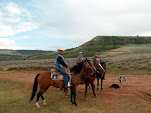Soldier Encampent on the Fort Phil Kearney fort site, August 5, 2017
Today we went with our youngest son, daughter in law, and
grandkids to the 150th anniversary re-enactment of the Wagon Box
Fight. We had a really fun time, cool day in Wyoming, mid 70's
with a breeze. It was actually jacket weather!
In 1864, gold was discovered in Montana. The trail to the gold
fields became known as the Bozeman Trail aka The Bloody Bozeman. Leaving the Oregon Trail west of present day Douglas, Wyoming, it went through prime Indian territory, full of water and game and
the Indians were instantly hot about the intrusion of the white
men. Red Cloud organized numerous attacks against the outposts,
especially Fort Phil Kearney near present day Story, WY.
Established in 1866, Fort Phil Kearney was closed in 1868 when
the Union Pacific reached far enough into the west that the
Montana Gold Fields could be reached through Idaho making the
dangerous Bozeman Trail obsolete. The Indians burned the fort to
the ground as soon as the soldiers left and when Hubby and I were
in middle school you could still see burned posts on the site. It
was practically all that was there. Now there is an interpretive
center, museum, and some reconstruction on the site.
Soldiers encampment
The Fort Cemetery (square in the distance) as seen from the fort grounds.
Several teepees were part of the encampment. The lady here was selling period consumer goods.
Indian saddles in front of the teepees.
In the case of the Bozeman Trail, there was an
alternative, the Bridger Trail which was mapped out by mountain
man Jim Bridger. Rather than running through Crow, Cheyenne, and
Sioux Territory, it ran through the Big Horn Basin in Shoshone and
Araphao territory who were much friendlier and less hostile. The
Bridger Trail lacked the plentiful game, and abundant water of the
Bozeman Trail/
It was used by around 450 or so emigrants in
1864-1866 at the start of the Montana gold rush with the trains being led by Jim Bridger. It left the
Oregon trail at Casper and went to present day Lysite, over the
Bridger Mountains (south end of the Big Horns) and then up to
Montana.
By 1866 however, most were using the Bozeman Trail and the
commander at Fort Laramie hired Jim Bridger to attempt to lessen
the hostilities on the Bozeman. Which meant Jim Bridger was
unavailable to lead any more wagon trains up the Bridger Trail.
The Bozeman Trail was part of what led directly to the Custer
fiasco on June 24, 1876.
Warriors gather before the fight.
Indian Women and children
Indians pursuing a cavaryman.
On August 2, 1867, a detail of 26 soldiers and 7 civilians left Fort Phil Kearney to cut wood. They were attacked by over 300 Indians led by Red Cloud. Due to the fact that the soldiers had just been
issued Springfield 1866 breech loading rifles and lever action Henry rifles, both of which fired much faster than the old ramrod rifles, they were able to hold off the indians with only 7 men killed.
The soldiers and civilians were protected by heavy wagons they had placed in a circle and unhitched the teams. The Indians drove off almost all of the horses and mules, however.
Soldiers at the fort learned of the woodcutter's peril from the observation station on nearby Pilot Hill who was signaling the fort to send out a rescue operation. Major Benjamin Smith led 103 soldiers along with 2 mountain howitzers to their rescue. Major Smith began firing the howitzers at long range, forcing the indian warriors to retreat.
The Battle
Pilot Hill is on the right in this photo. It's hard to see but you will note a 'bump' of something on top of the hill. That's the observators signaling with a huge flag!
The Sneak - once these two entered that tall grass you could barely tell where they were!
Our family watching. The grandson especially was Very Impressed with the performance.
Rescue on the Way!
Mountain Howitzers in place. They were brought in by the team on the wagon and the howitzers were hitched together so it only took one trip.
If you have never heard one fired, let me tell you they are LOUD!
One of the Artillery horses who brought in the howitzer along with a teammate. There was soldier who rode one of the horses pulling the howitzers to guide them as there was no where for anyone to sit to drive the team in a traditional manner.
The group of reenactors from Crow Agency, Montana. They did a wonderful job!
Many thanks to all of the state employees, volunteers and reenactors that made this possible. It was such a fun day that our family will always remember.





 A sandhill crane. (from Wilkepedia)
A sandhill crane. (from Wilkepedia)







































